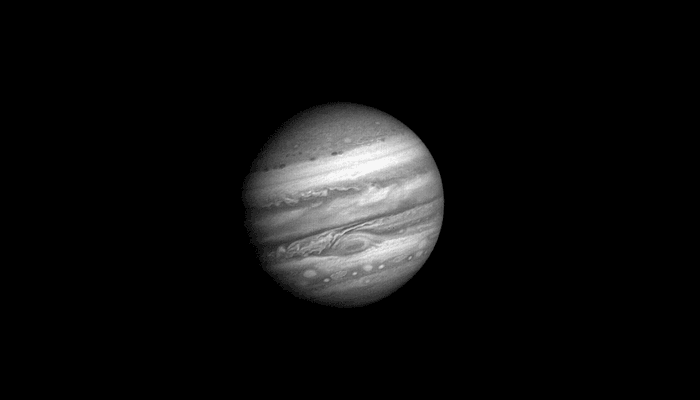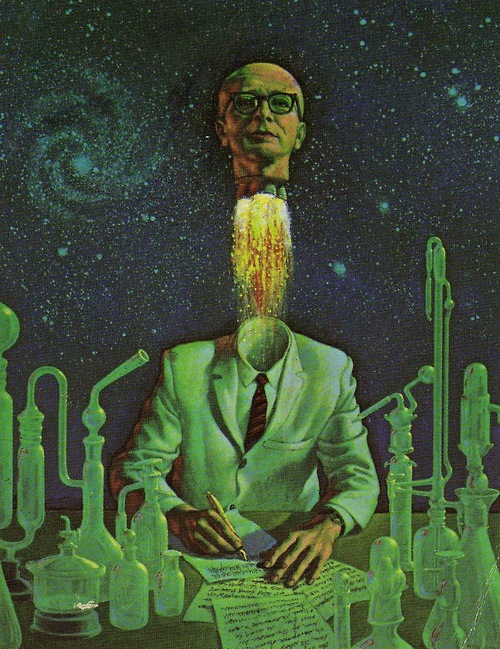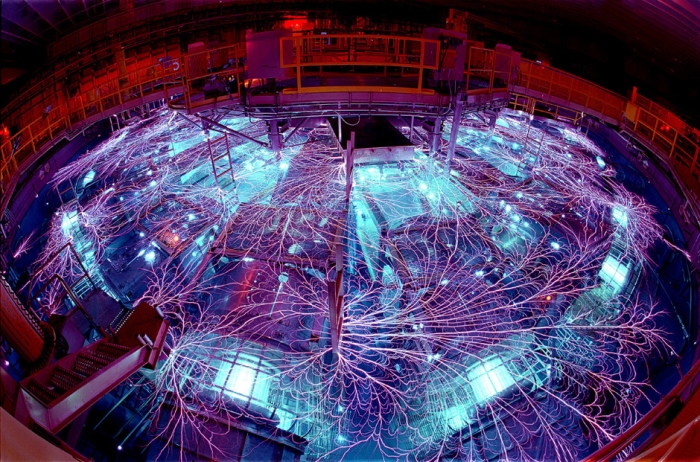Posts tagged 'Science'
The Flow
“The Flow looks at the supervening layers of reality that we can observe, from quarks to nucleons to atoms and beyond. The deeper we go into the foundations of reality the more it loses its form, eventually becoming a pure mathematical conception. Layer upon layer the flow builds new codes that create new codes, each version computing a new, more complex state based on the previous one.”
The attached was created by MRK, a London-based artist who helps scientists and researchers visualize their collected data. If you’re interested in knowing which units of matter are represented in each ‘segment’ definitely give the annotated version of The Flow a watch next.
A big thanks is due to hrcho for sending this one our way...cheers, mate!
[ The Flow ]
posted by respondcreate on Jan. 20, 2013 in Videos | tags: animation, biology, colorful, hd, mrk, nature, science, trippy
End of an Era
“There’s plenty of housework to be done here on earth – and our commitment to it must be steadfast – but we’re the kind of species that needs a frontier for fundamental biological reasons. Every time humanity stretches itself it receives a jolt of productive vitality that can carry it for centuries.” –Carl Sagan
Reid Gower was commissioned by NASA to create a series of films that would pay tribute to Carl Sagan, the brilliant mind the center of Cosmos: A Personal Voyage, one of my all-time favorite documentary series produced by PBS. The video attached above is part six of (currently) seven of The Sagan Series so click the previous link to see the rest of them. Oh and Cosmos is getting a reboot courtesy of Seth MacFarlane (of Family Guy fame) and Neil Degrasse Tyson, the host of NOVA scienceNOW (another fantastic PBS property that you can watch for free online). Needless to say, I’m really looking forward to it.
[ The Sagan Series (part 6) - End of an Era: The Final Shuttle Launch ]
posted by respondcreate on Aug. 31, 2011 in Videos | tags: astronomy, carl sagan, cosmos, hd, inspirational, nasa, reid gower, science, space, the sagan series
The Aurora Borealis
“The Sun acts as an enormous power plant. The energy is created deep inside the core of the Sun, here the temperature is over 14 million degrees and the pressure so enormous that hydrogen atoms are squeezed together into another element: helium.”
Time for some science, bitches – prepare to get your learn on! The Sun is an endlessly fascinating topic for me and this video, produced by forskning.no in concert with the Department of Physics at the University of Oslo, does a great job of explaining the complex process of how the Aurora Borealis forms in an easy-to-understand way. Speaking of which, my favorite way to wrap my head around complex topics, like nuclear fusion, is to first head over to Simple English Wikipedia. It’s page on The Sun is fantastic – “The sun is basically a very, very large ball of plasma bubbling with non-stop explosions. These explosions give off so much energy that if we could gather all the Sun’s energy for one second it would be enough to power the U.S.for 9 million years…more” – as are the entries pertaining to the Higgs Boson, strong force and the special theory of relativity. Don’t forget: knowledge is power.
Related: More Aurora Borealis on The Tripatorium™.
posted by respondcreate on Jul. 08, 2011 in Videos | tags: animation, astronomy, aurora borealis, colorful, educational, science, space, sun
Parallelostory
We’ve featured the work of Kelly Meador and Daniel Elwing (a.k.a. impactist) on the site before so it was no surprise when we found out this little astronomy-themed vignette came from them. Per the impactist M.O. they handle everything from the visuals to the music. The latter can be found for purchase here at the super-affordable rates of $1 a single or $3 for an EP (my personal favorites are the Last Heist and Color Fields & Wagon Wheels EPs). When you support art at reasonable prices you get more art at reasonable prices (sometimes for free). OK, enough with the soapbox. Enjoy your weekend, friends!
P.S. Thanks for all the fantastic submissions that have been coming in lately, we’re working our way through them!
[ Parallelostory ]
posted by respondcreate on May. 13, 2011 in Videos | tags: animation, astronomy, hd, impactist, love, science, space
Storm
“Does the idea that there might be knowledge frighten you? Does the idea that one afternoon on wiki-fucking-pedia might enlighten-you-frighten-you? Does the notion that there might not be a supernatural so blow your hippy noodle that you’d just rather stand in the fog of your inability to Google?”
Most of what we post here on The Tripatorium™ is fairly short and bite-sized so it’s always nice to come across something that’s a bit longer-form. This one is a treat – an instant classic – that rare bit of internet that simultaneously brings the LOL, provokes conscious thought and servers as a reminder of how beautiful and complex our collective existence is. ‘Storm’ began as a beat-poem by Australian comedian/performer Tim Minchin and was transformed into the animation you’re watching now by the talented DC Turner, a director/designer/animator currently freelancing in London. We hope you enjoy it as much as we did.
[ Tim Minchin's Storm the Animated Movie ]
posted by respondcreate on Apr. 10, 2011 in Videos | tags: animation, dc turner, hd, reason, science, spirituality, tim minchin
Voyager 1 Approaches Jupiter

“One frame of this image was taken each Jupiter day (approximately 10 hours) between January 6 and February 9, 1979, as the space probe [Voyager I] flew from 58 million to 31 million kilometers from Jupiter during that time. The small, round, dark spots appearing in some frames are the shadows cast by the moons passing between Jupiter and the Sun, while the small, white flashes around the planet, are the moons themselves.”
Inspired by the gorgeous shot of Jupiter’s ‘Great Red Spot’ tizmatti posted a couple of weeks back, I decided to read up on Jupiter’s unique atmosphere. Turns out it’s a pretty tumultuous place comprised of constantly shifting cloud layers and swirling, violent vortices (of which the ‘Great Red Spot’ is the largest). It’s truly fascinating stuff.
[ NASA: Jupiter via Wikipedia ]
posted by respondcreate on Apr. 08, 2011 in Pictures | tags: animated gif, astronomy, jupiter, nasa, science, space, time lapse, voyager
Walks of Life
Cayla Darling was kind enough to write in and tell us about an animation Cyriak created for Short Stories, a Showtime-sponsored series that challenges filmmakers to “tell a short story in an innovative way.” Mr. Harris’ chosen story was that of evolution and, as usual, delivered the goods. Thanks for the internets, Cayla!
[ SHORT stories: Walks of Life - Cyriak ]
posted by respondcreate on Apr. 01, 2011 in Videos | tags: animation, bizarre, cyriak, evolution, fingers, hd, science, trippy
The Known Universe
“The Known Universe takes viewers from the Himalayas through our atmosphere and the inky black of space to the afterglow of the Big Bang. Every star, planet, and quasar seen in the film is possible because of the world’s most complete four-dimensional map of the universe, the Digital Universe Atlas that is maintained and updated by astrophysicists at the American Museum of Natural History.”
This video is a personal favorite of mine – I’ve watched it around nine or ten times – and don’t know why it didn’t occur to me sooner to put it up on the site. The Known Universe was directed by Carter Emmart with music by Suke Cerulo. Read more on amnh.org.
[ The Known Universe by AMNH ]
posted by respondcreate on Mar. 28, 2011 in Videos | tags: amnh, astronomy, hd, science, space, spiritual, trippy, universe
Fly Neuron Brainbow

“You’re looking at the brainscan of a fruit fly, which has been injected with fluorescent proteins to trace out and highlight neuron networks in the brain, making each neuron glow one of a 100 custom colors.” –Adrian Covert, Gizmodo”
Scientists sure are smart. Read more about this fascinating process (called ‘brainbow’) at Technology Review.
[ Fly Over the 'Brainbow' via Gizmodo > FastCo ]
posted by respondcreate on Mar. 18, 2011 in Pictures | tags: brain, brainbow, colorful, fly, insects, nature, science, trippy
Scale
It’s difficult to get your mind around just how big stuff in our solar system is – never mind in the rest of the universe – which is why I love videos like this one from Brad Godspeed which shows how big some of the planets would appear in the sky if they orbited earth at the same distance as the moon.
Many thanks to Kenaldo for sending it in. Cheers!
[ Scale ]
posted by respondcreate on Feb. 10, 2011 in Videos | tags: astronomy, brad godspeed, planets, scale, science, trippy
Blast Off

After some quick sleuthing with Google Goggles I discovered that the origin of this fantastic illustration was as the cover of ‘Great Science Fiction by Scientists’.
posted by respondcreate on Feb. 09, 2011 in Pictures | tags: colorful, illustration, science, science fiction, trippy
Sound is touch at a distance.
flight404 took one of my favorite segments from radiolab and put it to a reactive processing piece he had created years earlier. It’ll reacquaint you with just how incomprehensibly complex of a miracle our bodies are.
[ Solar rework ]
posted by respondcreate on Feb. 03, 2011 in Videos | tags: flight404, radiolab, science, sound, trippy
Z Machine

This is the New Mexico based Z Machine, the largest x-ray generator in the world that was designed and built to test materials in extreme conditions.
“The Z machine fires a very powerful electrical discharge (several tens of millions of amperes for less than 100 nanoseconds) into an array of thin, parallel tungsten wires called a liner (pictured here). The high electrical current vaporizes the wires, which are transformed into a cylindrical plasma curtain. Simultaneously, the current density induces a powerful magnetic field and their combination creates Lorentz forces which radially compress the plasma into a z-pinch process.”
Sounds intense. Read more on the official Z Machine website or on wikipedia.
posted by respondcreate on Jan. 03, 2011 in Pictures | tags: light, lightning, nuclear, sandia, science, trippy
Coalescence Cascade
Behold! The coalescence cascade! (That would make a great band name, btw.)
[ Waterdrop shot in 10000 frames a second via Gizmodo ]
posted by respondcreate on Dec. 14, 2010 in Videos | tags: coalescence cascade, high speed photography, science, slow motion, trippy, water
Science is fun!
Don’t try this at home (just watch it on the internet to save yourself the time, effort, energy and hassle).
[ BURN STEEL (wool) via Gizmodo ]
posted by respondcreate on Nov. 28, 2010 in Videos | tags: experiment, fire, nerds, science, trippy